
 i_need_contribute
i_need_contribute
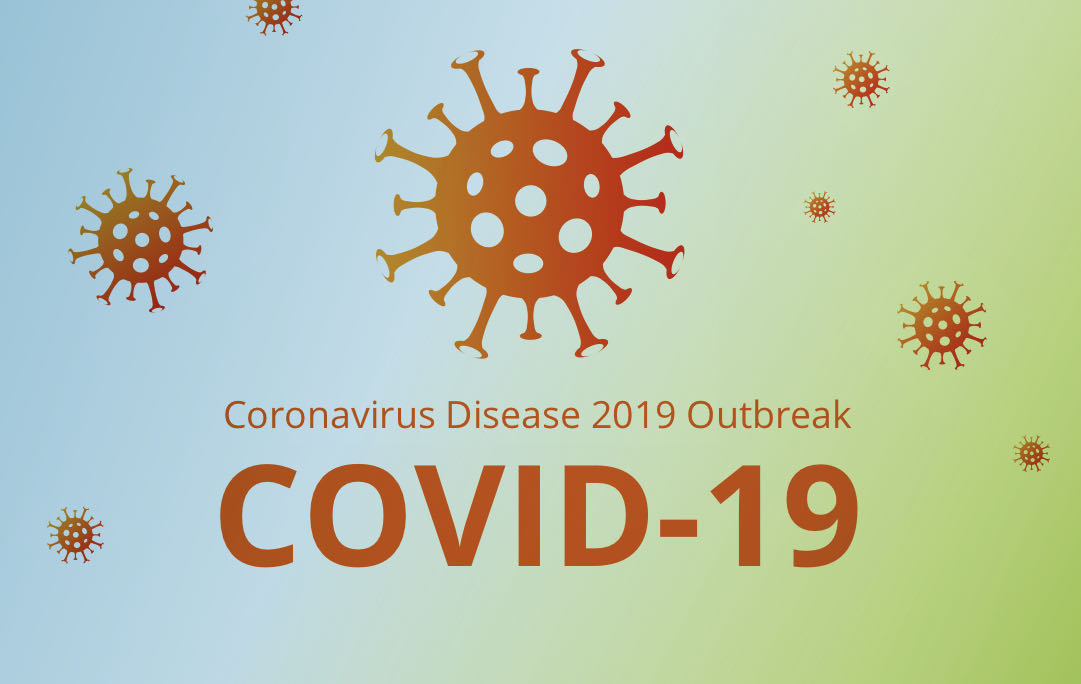
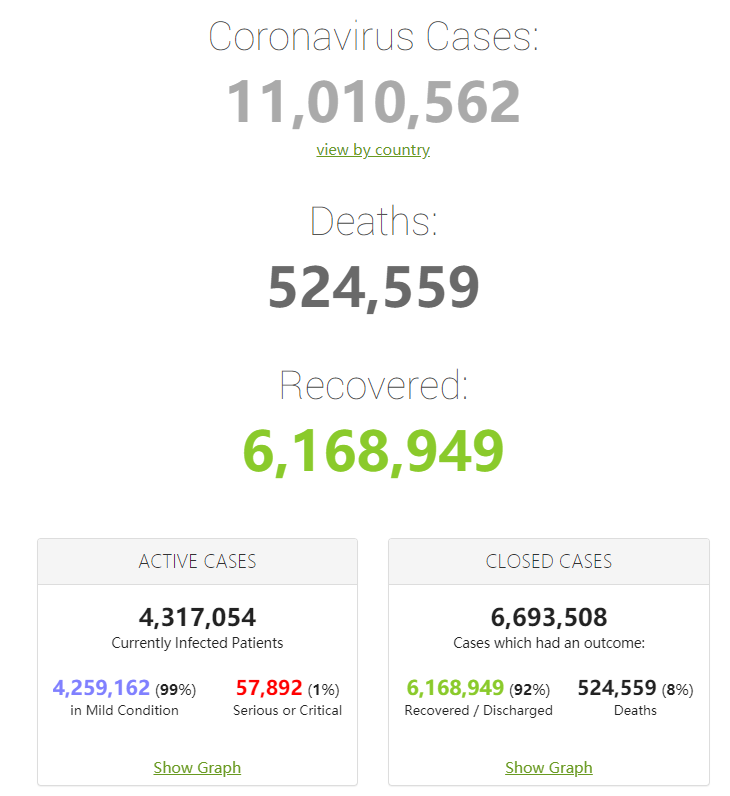
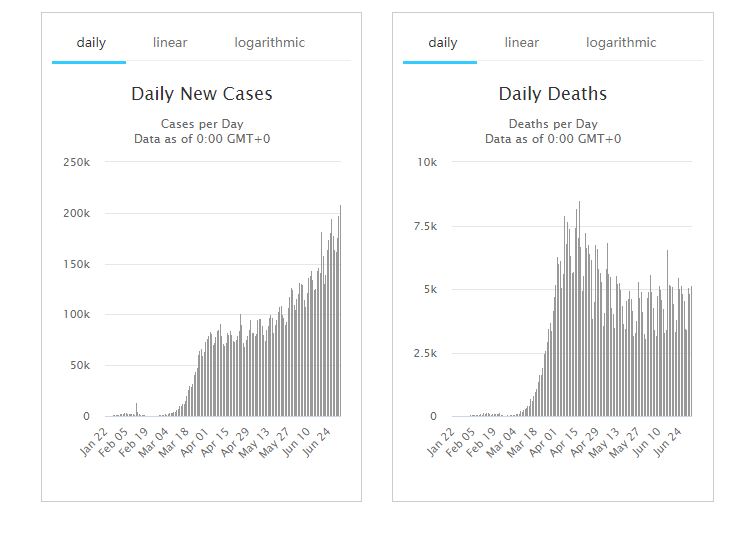
|
# |
Country, |
Total |
New |
Total |
|
|
World |
10,974,421 |
+208,864 |
523,242 |
|
1 |
2,837,189 |
+57,236 |
131,485 |
|
|
2 |
1,501,353 |
+47,984 |
61,990 |
|
|
3 |
661,165 |
+6,760 |
9,683 |
|
|
4 |
627,168 |
+21,948 |
18,225 |
|
|
5 |
297,183 |
+444 |
28,368 |
|
|
6 |
292,004 |
+3,527 |
10,045 |
|
|
7 |
284,541 |
+2,498 |
5,920 |
|
|
8 |
283,757 |
+576 |
43,995 |
|
|
9 |
240,961 |
+201 |
34,818 |
|
|
10 |
232,863 |
+2,652 |
11,106 |
|
|
11 |
231,770 |
+5,681 |
28,510 |
|
|
12 |
217,809 |
+4,339 |
4,473 |
|
|
13 |
202,284 |
+1,186 |
5,167 |
|
|
14 |
197,608 |
+3,383 |
1,752 |
|
|
15 |
196,717 |
+393 |
9,064 |
|
|
16 |
168,061 |
+8,728 |
2,844 |
|
|
17 |
166,378 |
+659 |
29,875 |
|
|
18 |
153,277 |
+4,019 |
1,926 |
|
|
19 |
106,110 |
+4,101 |
3,641 |
|
|
20 |
104,772 |
+501 |
8,642 |
|
|
21 |
97,897 |
+894 |
118 |
|
|
22 |
83,537 |
+3 |
4,634 |
|
|
23 |
71,299 |
+1,485 |
3,120 |
|
|
24 |
70,639 |
+250 |
5,411 |
|
|
25 |
69,941 |
+2,744 |
1,385 |
|
|
26 |
62,698 |
+274 |
405 |
|
|
27 |
61,598 |
+89 |
9,761 |
|
|
28 |
59,468 |
+1,211 |
4,639 |
|
|
29 |
59,394 |
+1,624 |
2,987 |
|
|
30 |
53,708 |
+2,184 |
2,160 |
|
|
31 |
50,335 |
|
6,113 |
|
|
32 |
49,469 |
+400 |
317 |
|
|
33 |
47,859 |
+919 |
359 |
|
|
34 |
45,887 |
+889 |
1,185 |
|
|
35 |
44,310 |
+188 |
26 |
|
|
36 |
42,782 |
+328 |
1,587 |
|
|
37 |
42,574 |
+1,509 |
188 |
|
|
38 |
42,555 |
+1,361 |
188 |
|
|
39 |
38,805 |
+294 |
1,274 |
|
|
40 |
35,237 |
+774 |
667 |
|
|
41 |
35,146 |
+371 |
1,492 |
|
|
42 |
34,227 |
+1,008 |
1,201 |
|
|
43 |
34,197 |
+810 |
765 |
|
|
44 |
32,022 |
+186 |
807 |
|
|
45 |
31,967 |
+116 |
1,965 |
|
|
46 |
27,837 |
+423 |
94 |
|
|
47 |
27,746 |
+450 |
1,687 |
|
|
48 |
27,110 |
+626 |
616 |
|
|
49 |
27,047 |
+790 |
324 |
|
|
50 |
26,658 |
+593 |
459 |
|
|
51 |
25,489 |
+12 |
1,738 |
|
|
52 |
20,262 |
+704 |
542 |
|
|
53 |
19,011 |
+915 |
817 |
|
|
54 |
18,874 |
+151 |
975 |
|
|
55 |
18,684 |
+572 |
228 |
|
|
56 |
18,134 |
|
117 |
|
|
57 |
17,941 |
+68 |
705 |
|
|
58 |
17,150 |
+252 |
560 |
|
|
59 |
15,195 |
+359 |
287 |
|
|
60 |
14,657 |
+385 |
928 |
Source:https://www.worldometers.info/coronavirus/
Vice President Mike Pence changed his travel plans in Arizona after Secret Service agents set to accompany with him tested positive for the coronavirus or showed symptoms, two administration officials said on Thursday.
Mr. Pence had been scheduled to visit Arizona on Tuesday, but multiple factors related to the spread of the virus foiled those plans, according to a person familiar with Mr. Pence’s travel.
A swift rise in new cases in the state has overwhelmed testing centers in recent days, and Gov. Doug Ducey, a Republican, ordered bars, gyms and movie theaters closed this week. In an apparent acknowledgment of outbreaks erupting across the South and the West, the vice president canceled his plan to headline a “Faith in America” campaign rally in Tucson on Tuesday and then tour Yuma with Mr. Ducey.
Instead, Mr. Pence opted for a shorter visit to Phoenix on Wednesday, where he participated in a public health briefing at Sky Harbor International Airport.
“Help is on the way,” Mr. Pence said at a news conference with Mr. Ducey at the airport, after descending the steps of Air Force Two wearing a mask, the latest sign of the administration’s evolving stance on face coverings.
But the positive tests and symptoms of Secret Service agents expected to be in proximity to the man who is second in line for the presidency were some of the factors that prompted his change of schedule, the officials said. The news of the agents who showed symptoms of Covid-19, or tested positive, was first reported by The Washington Post.
A spokeswoman for Mr. Pence did not respond to a request for comment.
The latest illnesses among the small circle of individuals who interact directly with the vice president were a reminder of the dangers of carrying on with campaign and official government travel as the pandemic rages on.
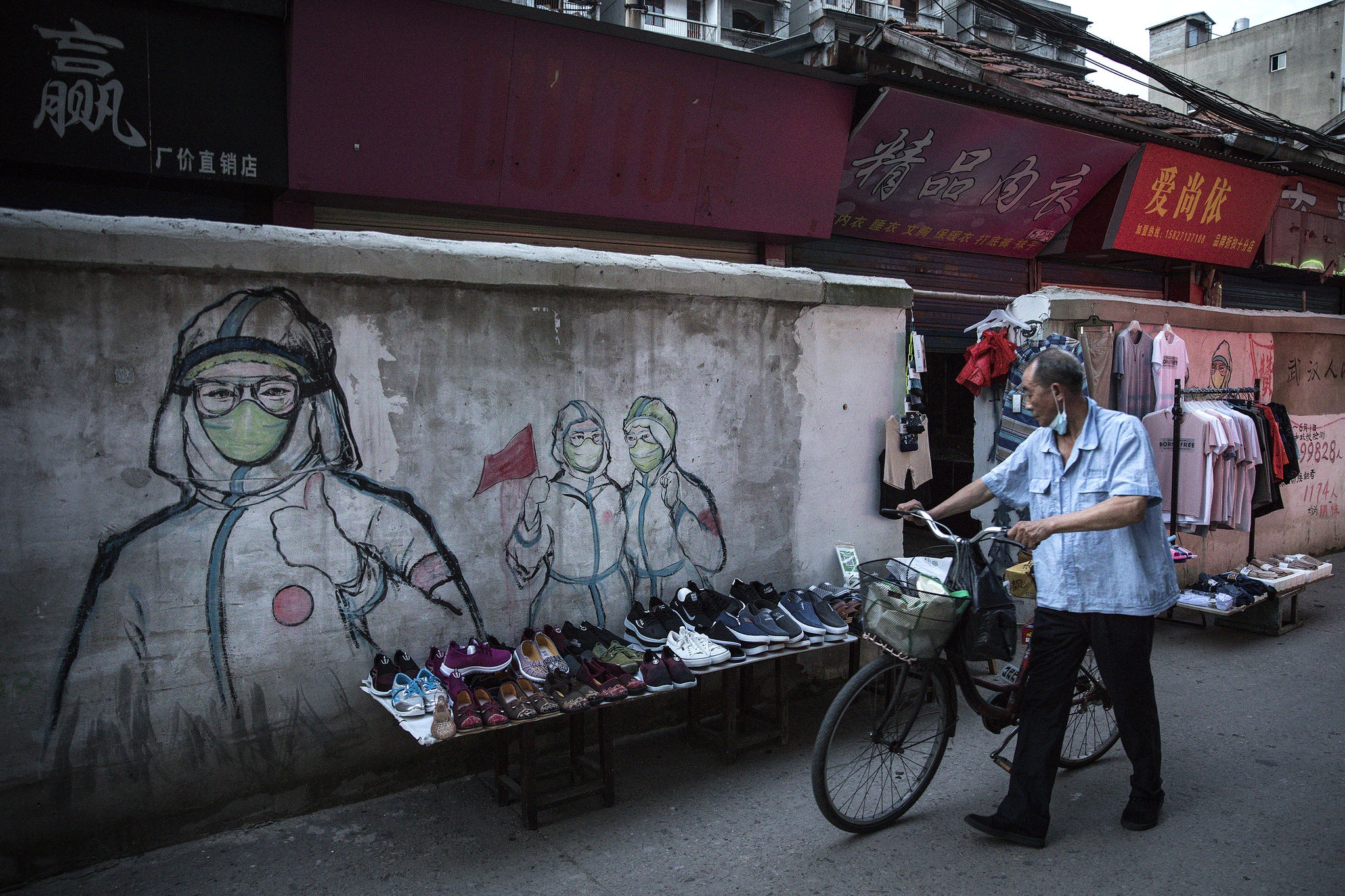
In Wuhan, the central Chinese city where the coronavirus is believed to have first emerged.Credit...Getty Images
China appears to be downplaying expectations ahead of a planned trip next week by a World Health Organization team to the country to investigate the origins of the coronavirus outbreak.
Since the head of the World Health Organization announced the trip on Monday, several Chinese officials and experts have weighed in, saying that any investigation into the origins of the virus should not only focus on China.
“It does not matter which country the scientific identification work starts with, as long as it involves all related countries and is fairly conducted,” Zeng Guang, the chief epidemiologist for the Chinese Center for Disease Control and Prevention, told the state-run nationalist newspaper Global Times on Tuesday.
Wang Guangfa, a top government health adviser, told Global Times this week that the World Health Organization should also go to Spain. He cited a not-yet-published study by researchers at the University of Barcelona that suggests the new coronavirus was present in Spain’s wastewater as early as March 2019.
Independent experts have said the study was flawed, and that other lines of evidence strongly suggest the virus emerged in China late last year.
The virus most likely originated in bats, but the path of transmission is still unknown. Experts say establishing that will be a crucial step in preventing future outbreaks.
The hunt for information has focused on Wuhan, the central Chinese city where the virus is believed to have first emerged, and specifically the Huanan Seafood Market, which was said to have sold wildlife and had links to many of the country’s first reported cases.
Mike Ryan, head of the W.H.O.’s emergencies program, said on Wednesday that the agency would be sending two experts from Geneva to join its China country team on next week’s trip. He said one would likely be an epidemiologist and the other an expert in animal health.
Dr. Ryan did not reveal which cities the team were planning to visit. He described it as a “scoping mission.”
Getting answers on the origins of the virus has become more difficult as the issue has become increasingly politicized. China has been on the defensive for months in response to growing criticism from the United States and other countries for its initial mishandling of the outbreak. Officials from both the United States and China have, without providing evidence, accused one another of intentionally releasing the virus.
But at a regular press briefing this week, a Chinese foreign ministry spokesman sounded a less-aggressive note.
“China has always believed that virus tracing is a scientific issue, and relevant research should be carried out by scientists and medical experts,” said Zhao Lijian, the spokesman, who in March promoted a theory that the U.S. Army purposely introduced the virus to China.
“China continues to support scientists from all over the world in conducting global scientific research on the source and spread of viruses,” he added.
By a 5-to-4 vote, the Supreme Court on Thursday blocked a trial judge’s order that would have made it easier for voters in three Alabama counties to use absentee ballots in this month’s primary runoff election.
In March, Gov. Kay Ivey, a Republican, postponed the election because of the pandemic. At the same time, the Republican official who oversees the state’s elections, John H. Merrill, Alabama’s secretary of state, expanded the availability of absentee ballots to all voters who concluded that it was “impossible or unreasonable to vote at their voting place.”
But Mr. Merrill did not relax two of the usual requirements for absentee voting: submission of a copy of a photo ID with a voter’s application for a ballot and submission of an affidavit signed by a notary public, or two adult witnesses, with the ballot itself.
Four voters and several groups sued to challenge those restrictions, saying that, in light of the health crisis, they placed an unlawful burden on the right to vote. Making a copy of a piece of identification, for instance, may be difficult and dangerous during the pandemic, they said.
Officials in Alabama, which has more than 40,000 confirmed coronavirus cases and nearly 1,000 deaths, have dismissed that concern.
In asking the Supreme Court to intervene, state officials said an order by an Alabama judge — which, among other things, blocked election officials in two counties from enforcing the ID requirement for voters who are disabled or 65 or older — had come too close to the election and threatened its integrity.
In their brief, the state officials discussed ways in which voters could safely comply with the witness requirement.
In response, lawyers for the voters said the state had offered no good reasons “to justify the application of the witness or photo ID requirements to high-risk voters in the middle of a pandemic.”

San Marco's Square in Venice, Italy, last week.Credit...Andrea Merola/EPA, via Shutterstock
Long before Venice became a hot spot for international travelers, locals would practice the tradition of flânerie, an aimless stroll through the city’s calli, or walkways.
Now flânerie is back: The pandemic has crushed the tourism industry, and many residents have more time and space to enjoy the city’s slow pace and faded beauty, even if money is tight.
Venice is one of several European cities that rely heavily on tourism and was particularly vulnerable to pandemic’s economic side effects. Some economists have even described it as a “tourism monoculture,” borrowing the term from the risky agricultural practice of growing a single crop.
Some residents and officials now hope that city’s economy can begin to move away from that monoculture — for example, by drawing in international investors and expanding the footprint of its two universities.
“We have to act now, before mass tourism will be back at full capacity, because we won’t get a second chance,” said Paolo Costa, an economics professor and former mayor of Venice.
There is a growing recognition across party lines that Congress will need to spend more money, soon, to continue to prop up the American economy.
But there is little consensus on what the next aid package should look like and how quickly it will arrive.
Some economists say lawmakers are risking further damage to an already fragile recovery by not moving more quickly. Real-time indicators of shopping patterns and business openings suggest that a once-brisk economic rebound stalled in June as the virus began spreading more rapidly in Texas, Florida and other states. And even the most encouraging signs of recovery — such as the jobs report released today, which said U.S. payrolls grew by 4.8 million in June — underscore how far the recovery still has to get back to what was normal before the virus: Nearly 18 million Americans remain unemployed.
Lobbyists and lawmakers say the Trump administration, which has lost several economic advisers in recent weeks, is not deeply engaged in devising another rescue package. Officials have hinted for weeks that they would formally propose tax cuts, infrastructure spending and other initiatives, but they have not followed through. Mr. Trump has expressed support for additional tax cuts and government spending.
Senators are expected to leave Washington on Thursday after making only incremental progress toward an agreement to extend further relief to businesses and laid-off workers who are about to lose or have already exhausted federal assistance.
“The stimulus was very short-lived,” said Aneta Markowska, chief economist at the investment bank Jefferies. “This problem is going to persist long beyond July.”
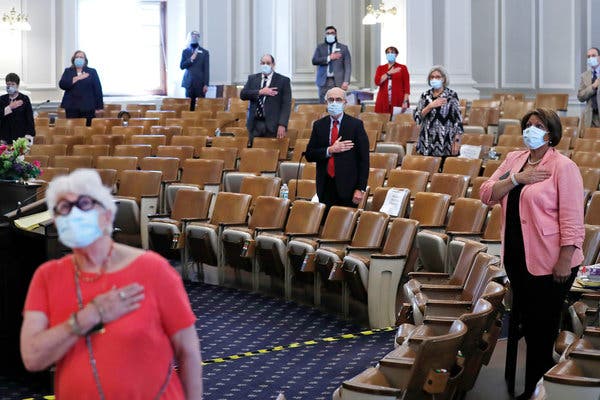
Members of the New Hampshire State Senate in Concord socially distancing in June.Credit...Charles Krupa/Associated Press
As the virus has exploded in large swaths of the nation over the past two weeks, only a dozen states, mostly in the Northeast, have managed to keep new case levels flat or declining.
New York, which averaged 9,877 cases per day when it reached the height of its outbreak in April, has been staying mostly flat at an average of 620 cases per day. Other states in the Northeast that were initially hit hard, including New Jersey, Connecticut, Massachusetts and Rhode Island, are all plateauing at far lower levels than earlier in the pandemic.
Massachusetts announced Thursday that it would move forward with the next phase of its reopening on Monday for all areas of the state except for Boston.
Movie theaters, outdoor performance venues, fitness centers, museums and other businesses will be allowed to resume operations. Up to 25 people will be allowed to gather in indoor spaces, provided that they are adequately spaced. Boston is scheduled to ease its restrictions in those areas on July 13.
“Today the public health data makes clear that Massachusetts is effectively bringing the fight to the virus as we’ve reopened,” Gov. Charlie Baker said at a news conference Thursday.
Other states where new cases have stayed largely the same over the past two weeks, according to a New York Times database, include Vermont, Maryland, Virginia, Indiana, Nebraska and South Dakota.
The state showing the biggest decline in new cases over the past two weeks, according to the database, was New Hampshire. Its decline has been modest: It is now averaging 29 new cases a day, down from over 34 cases a day two weeks ago.
But its governor, Christopher T. Sununu, said that the state should not expect its declines to last.
“I actually think a spike in Covid cases will happen in New Hampshire, and that is the real tough situation that we have,” he said Wednesday on WMUR. “It would be very ignorant and arrogant of us to think that we are going to be completely immune to what’s happening in other parts of the country.”
“The reason the spikes are happening in other parts of the country aren’t just because they’re reopening,” he said, adding that many people in other areas, and particularly young people, were not wearing masks or practicing social distancing.
“Unfortunately I think we are going to see some outbreaks here,” he said. “The key is here we can manage it this time: We have P.P.E., we have testing capabilities, we have more financial resources.”

An empty playground outside Public School 145 in Manhattan after the city closed schools in April.Credit...Juan Arredondo for The New York Times
Mayor Bill de Blasio said Thursday that New York City schools would open in some form come September — only for Gov. Andrew M. Cuomo’s office to describe the mayor’s announcement as “premature.”
“We value the opinion of local politicians and the state’s 700 local school districts as to what should be done, but the public should not be confused on this important decision that has practical consequences for many,” Dani Lever, Mr. Cuomo’s spokeswoman, in a statement.
The lack of coherent communication from the state and the city about the nation’s largest school system sowed further confusion among public school parents eager for clarity about the coming school year. Some private schools are also are likely to follow the public school path.
It is not the first time the two officials have differed on schools. In April, when Mr. de Blasio announced that they would remain closed for the rest of the school year, Mr. Cuomo discounted it as merely the mayor’s “opinion.”
For months, Mr. de Blasio has suggested that schools would reopen in some form in September, On Thursday, he offered slightly more clarity.
The mayor said that students and teachers would be required to wear masks, that schools would get daily deep cleanings, and that each school would welcome the maximum daily number of students possible, given social distancing and other health requirements.
He cited a recent survey of public school parents finding that 75 percent of them want their children to return to class this year. The survey got 400,000 responses.
On Thursday, the schools chancellor, Richard A. Carranza, met with principals to discuss plans for reopening. The schools will be able to reopen only with buy-in from unionized teachers and staff members.
The teachers union president, Michael Mulgrew, said he anticipated the city would release its models for “blended” virtual and in-person learning next week.
“Our final decision about moving ahead in September depends upon medical and scientific assessments concerning the virus and its containment,” Mr. Mulgrew wrote in a Thursday email to members. “The changing nature of these assessments means we must wait to make that decision closer to the first day of school even though we know that delay creates difficulties for parents and educators alike.”
The British government failed to heed early warnings that domestic abuse would soar during the lockdown. Now, more than four months later, it is still lagging in its response.
For some victims trapped with their abusers, the consequences have been catastrophic.
In the first month after the lockdown began in late March, 16 women and girls were killed in suspected domestic homicides — more than triple the number in the same period in 2019. At least 10 more have died in the two months since then.
Distress calls to abuse hotlines are soaring, charities are overwhelmed and some emergency housing providers cannot meet demand.
The courts offer limited help, at best. Overwhelmed by lengthy delays, they have allowed some accused of abuse to return home, despite restraining orders.
Other countries have fared better.
New Zealand included domestic abuse preparations in its lockdown planning from the start. Italy, Spain and other countries set up nationwide programs to house abuse victims in hotels if existing shelters were full. Germany made an open-ended pledge to fund shelters and other services.
Britain did none of this.
Interviews with more than 50 government and law enforcement officials, academic experts, front-line support workers and abuse survivors show that British leaders never prioritized domestic abuse in lockdown planning and are still failing to quickly provide help.
“There is no defined government strategy at all,” said Jess Phillips, a Labour lawmaker who speaks for the opposition on domestic violence policy. “Some services have got no funding to keep going.”
The government contests that. Victoria Atkins, the minister in charge of the government’s response to domestic violence, said in a statement that the authorities were “committed to supporting victims and bringing perpetrators to account.”
As Florida reported on Thursday more than 10,100 new cases, breaking another single-day record, Miami-Dade Mayor Carlos A. Gimenez said that he was imposing a countywide curfew from 10 p.m. to 6 a.m., starting Friday and until further notice.
“This is one of various actions I’m pursuing to tamp down this spike of Covid-19 and protect our residents,” he said in a statement. He is also rolling back the opening of movie theaters, arcades, casinos, concert halls, bowling halls and adult entertainment venues that recently had their plans approved by the county.
“People going to restaurants will also have to keep their masks on while seated at their table — removing the mask only to eat and drink,” he said.
Miami-Dade and Broward counties had already announced they were closing beaches for the busy Fourth of July weekend.
Florida reported Thursday that an 11-year-old boy in Miami-Dade County had died, the youngest death attributed to Covid-19 in the state.
Case numbers had been lower earlier in the week, but that may have been because fewer test results were being reported each day. Nearly 69,000 results were reported on Thursday, compared with about 45,000 on Wednesday.
Vice President Mike Pence visited the state Thursday and met with Gov. Ron DeSantis to discuss the state’s rapidly worsening outbreak. The visit was quite different in tone from one in May, when the two men ate, unmasked, at a burger bar and Mr. Pence praised the state’s reopening plans, saying, “I really think Florida has set the pace.” Back then Mr. DeSantis proclaimed “we’ve succeeded,” and added, “I think that people just don’t want to recognize it because it challenges their narrative.”
On Thursday, both men wore masks, but removed them to speak at a news conference, and Mr. Pence said that the federal government would work with the state to help flatten its curve. “The economic comeback that is underway is a demonstration that we don’t have to choose between opening up America and the health of our people: We can do both,” he said. “And that’s the challenge that we face today across the Sun Belt.”
Contact tracers, unable to keep up with so many new cases, have become overwhelmed by the surge.
“We are starting to lose the ability to do contact tracing,” said Dr. J. Glenn Morris, director of the Emerging Pathogens Institute at the University of Florida.
City and county officials desperate to stop the spread have adopted local mask mandates and closed the beaches over the holiday weekend. Some communities are deploying teams of public employees to go door-to-door in the hardest hit neighborhoods, distributing masks, hand sanitizers and fliers with information on symptoms and testing.
Testing demand has remained high: In Miami-Dade County, which has averaged more than 1,400 daily cases, the biggest testing sites begin taking appointments at 9 a.m. for the next day and have filled them by 9:30 a.m., county officials said. “The requests for testing have exploded,” said Maurice Kemp, county deputy mayor.
While thousands of Britons wait for their government to loosen curbs on summer foreign travel, one person has gone abroad anyway: Stanley Johnson, father of Prime Minister Boris Johnson.
Mr. Johnson, 79, posted pictures on social media of his arrival in Greece, a country that currently does not allow entry to travelers flying directly from Britain, which has the world’s fifth-highest number of virus cases, according to a Times database.
The trip, apparently made via Bulgaria, defies official British government guidance urging Britons not to go abroad unless they have to, and at a time when those returning to Britain must quarantine for 14 days.
An announcement on the relaxation of those rules had been expected on Thursday but was delayed as the government struggled to finalize its plan to allow Britons to return from dozens of nations without quarantine.
Speaking from Greece, Stanley Johnson told the Daily Mail newspaper that he had traveled to Greece via the Bulgarian capital, Sofia, and was abroad on “essential business trying to Covid-proof my property in view of the upcoming letting season.”
It is not the first time Mr. Johnson has defied the official advice of his son or his government on how to control the outbreak. In March, when the prime minister urged Britons not to visit pubs before the lockdown took effect, Stanley Johnson said he would go anyway if he felt the need.
For months, scientists have debated whether a variant of the virus that has come to predominate in much of the world did so partly because it is more transmissible than other viruses. On Thursday, a team of researchers reported new evidence suggesting that the variant did have such an advantage.
The new paper, led by Bette Korber, a theoretical biologist at Los Alamos National Laboratory, and posted by the journal Cell, presents evidence in the form of lab findings, tests of infected patients and a broad statistical analysis of the pandemic as the D614G variant took over in cities, regions and countries. “The consistency of this pattern was highly statistically significant, suggesting that the G614 variant may have a fitness advantage,” the authors concluded.
The underlying question is important for understanding the early phases of the pandemic and anticipating how it will progress in the coming months. If the genetic glitch that defines the variant imparted even a slight increase in transmissibility, it would help explain why infections exploded in some regions and not in others with similar density and other attributes.
Skeptics argue that it is far more likely that the variation spread widely by chance, multiplying outward from explosive outbreaks in Europe.
“This is an extraordinarily challenging problem,” said Dr. Marc Suchard, a biostatistician at the University of California, Los Angeles, School of Medicine. “The evolution and demography are complex. So there’s much more work to be done.”
From CNN's Maggie Fox
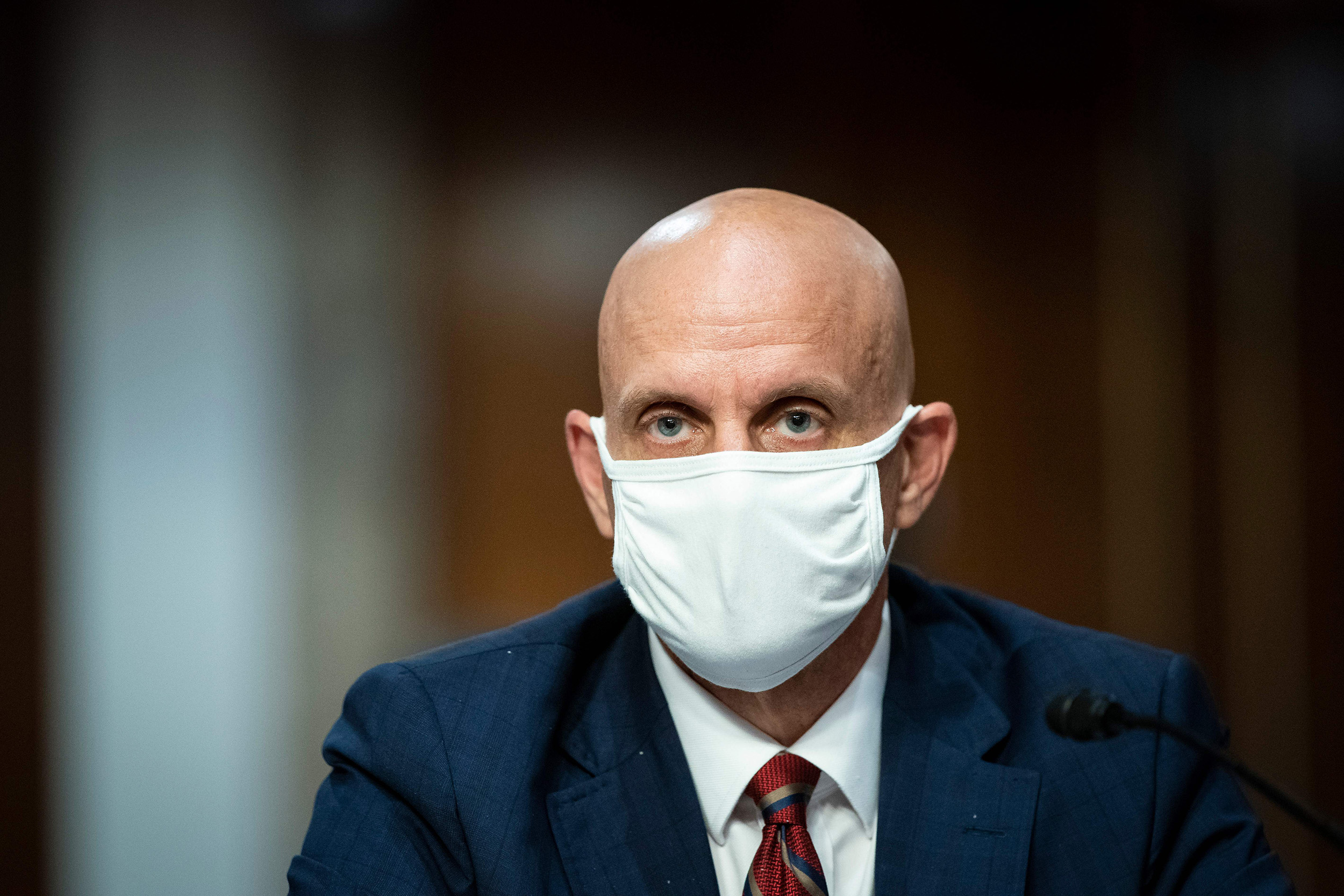
Food and Drug Administration Commissioner Dr. Stephen Hahn during a committee hearing in Washington, DC, on June 30. Al Drago/AFP/Getty Images
Earlier today, the US Food and Drug Administration authorized a new test that diagnoses both influenza and the novel coronavirus.
The test, designed by the US Centers for Disease Control and Prevention (CDC), is the first dual test to get emergency use authorization from the FDA.
“With the authorization of these tests, the FDA is helping address concerns in anticipation of this upcoming flu season during the Covid-19 pandemic, which might be especially worrying for some Americans,” FDA Commissioner Stephen Hahn said in a statement.
“With just one swab or sample, combination tests can be used to get answers to Americans faster. This efficiency can go a long way to providing timely information for those sick with an unknown respiratory ailment.”
From CNN's Rodrigo Pedroso in São Paulo and Taylor Barnes in Atlanta
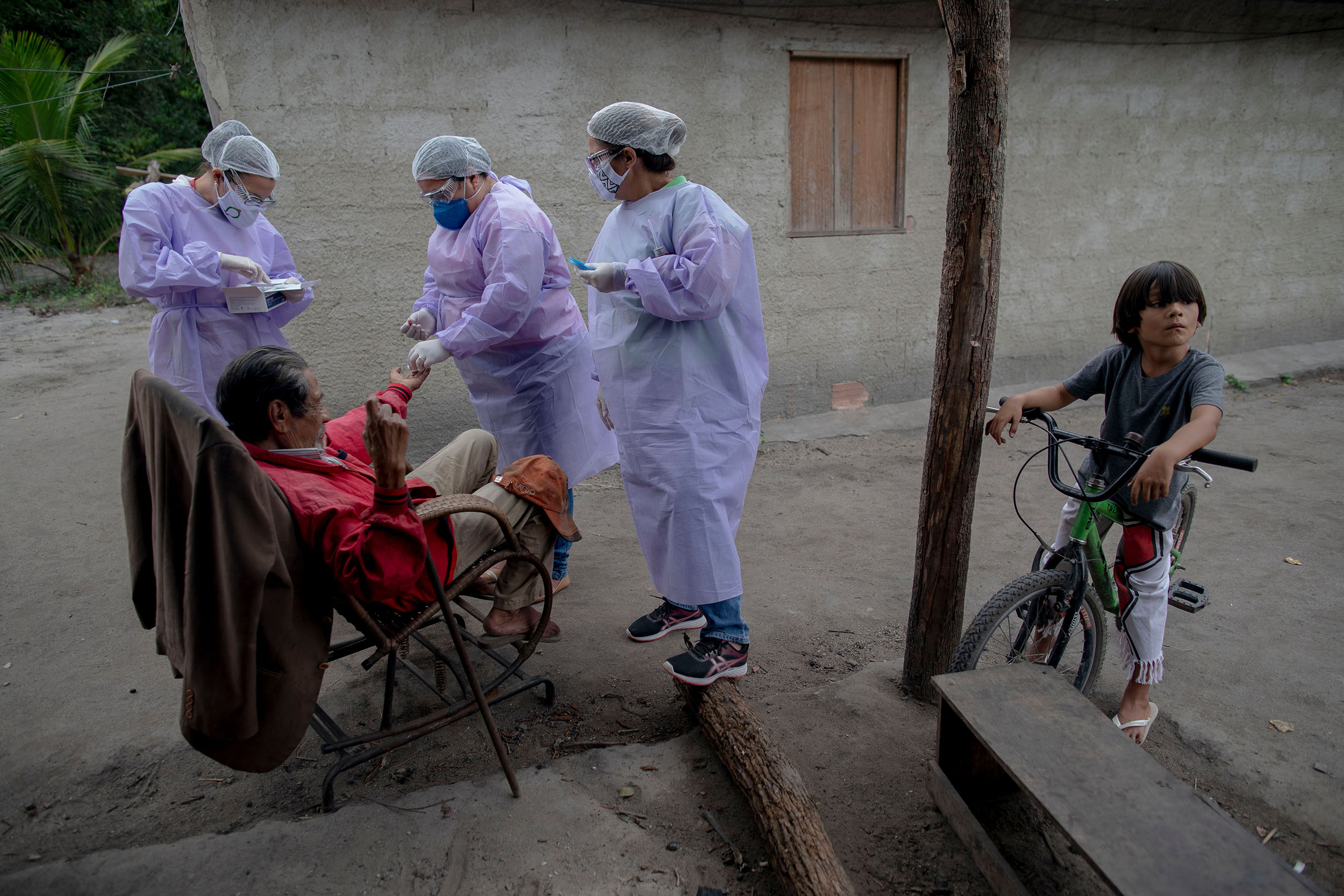
Health professionals administer COVID-19 tests to an elderly indigenous Guarani man in Marica, Brazil, on July 2. Mauro Pimentel/AFP/Getty Images
Brazil’s health ministry reported 48,105 new cases of the novel coronavirus on Thursday, taking the country’s total to 1,496,858.
Thursday's figures represent the second-highest daily jump in new cases since the pandemic began. The highest was recorded on June 19, when 54,771 new cases were recorded within 24 hours.
The ministry also reported 1,252 related deaths on Thursday, bringing the nationwide toll to 61,884.
From CNN's Tatiana Arias in Atlanta

A passer-by walks past a closed restaurant with the sign that reads 'everything will be alright' on July 02, in Bogota, Colombia. Guillermo Legaria/Getty Images
Up to 41 million people could be left unemployed by the coronavirus pandemic in Latin America and the Caribbean, the International Labor Organization (ILO) warned in a new report Wednesday.
“The unemployment rate could rise between 4 and 5 percentage points, bringing the number of unemployed in the region to a historical record of 41 million people. If the crisis worsens, the employment situation could worsen, amplifying social inequalities,” the report said.
Before the pandemic hit, the unemployment rate in Latin America and the Caribbean was 8.1% -- about 26 million people by the end of 2019, according to ILO.
The report analyzed data from the World Bank, which estimates a 7.2% drop in the region’s economic growth – leading to an 12.3% unemployment rate.
The ILO also analyzed the latest numbers from the International Monetary Fund, which estimated an economic contraction of 9.4%, resulting in a 13% unemployment rate.
What the rates mean: “In absolute numbers, these rates imply an increase in the number of people who are looking for a job and do not get it; from 26 million before the pandemic to 41 million in 2020,” ILO specialists explained at a press conference on Wednesday.
Where unemployment will hit hard: Various economic sectors are seeing high rates of unemployment. About 40% of workers are in high-risk sectors of hospitality, food service, small businesses and manual labor.
Another 17% are in the medium-to-high risk sectors, and only 20% of the labor force is engaged in low-risk economic activities such as those in government, education and health jobs.
"About 60% of those employed in Latin America and the Caribbean are exposed to significant losses of employment, hours worked and income,” according to the report.
From CNN's Lauren Mascarenhas

Dr. Anthony Fauci, director of the National Institute of Allergy and Infectious Diseases, speaking at a Senate hearing on June 30, in Washington, DC. Al Drago/Getty Images
It's impossible to pinpoint exactly what caused the fresh coronavirus case spike in the US, the country's top infectious disease expert Dr. Anthony Fauci said.
But a range of simultaneous factors -- like protests, political rallies, Memorial Day celebrations and state reopenings -- probably contributed, Fauci said in an interview with Harvard Business Review on Thursday.
“It’s very difficult to say that this particular demonstration, or that particular rally, or that particular holiday at a beach did it,” Fauci said. “But something happened to make the spike go way up like that.”
The rise in cases comes amid reopening efforts in the US, which Fauci said never completely closed in many respects.
“When the European Union shut down… about 95 or more percent of the country truly locked down,” he said. “When we were in our lockdown, about 50% of the country was in lockdown.”
Fauci said the disparate response to the pandemic among different states, regions and cities made a unified approach difficult, “probably to our detriment.”
Source:https://edition.cnn.com/world/live-news/coronavirus-pandemic-07-03-20-intl/index.html
Here are the key global developments in the coronavirus pandemic from the last few hours:
· Global cases are nearing 11 million. There are 10,842,615 known infections worldwide, and 520,785 deaths.
· The past week has seen the US break its own one-day case record four times, according to data compiled by researchers at Johns Hopkins University. In the seven days up to and including 1 July, the country, which has the highest number of cases and deaths worldwide, confirmed more than 40,000 cases on four separate days. On Wednesday. also saw cases rose by more than 50,000 for the first time in the US, with 51,200 confirmed in 24 hours.
· Brazil, second only to the US in terms of number of cases and deaths, has almost 1.5 million confirmed infections, after it added 48,105 new cases on Thursday. Cases there stand at 1,496,858, with deaths at 61,884. Brazil has reported more than 40,000 daily cases at least three times in the past week.
· The leading health official in the state of Sonora, Mexico, has asked the federal government to temporarily close the border to non-essential visits from the US, in response to a spike in virus cases reported in Arizona. Mexico’s coronavirus outbreak also rose by a record 6,741 confirmed cases and 679 deaths on Thursday, putting the country’s death toll at 29,189.
· The United Nations has predicted that more than 2.7m businesses could go under and 8.5m jobs could be lost in Latin America due to the coronavirus crisis. The UN’s economic commission for the region said shops, hotels and restaurants, many of which are small- and medium-size businesses, will be hardest hit.
· Australia’s state of Victoria is still struggling to contain a new outbreak, with 66 additional cases confirmed on Friday. The state health minister, Jenny Mikakos, said on Friday there was evidence of a “super-spreader” in the Victorian outbreak.
· In Tokyo, Japan, more 120 new cases were found on Friday, the Nikkei newspaper reported. On Thursday, the metropolis confirmed 107 new cases, the most in two months, but the government – eager to revive a slumping economy – said it was not planning to reimpose the emergency that was lifted on 25 May. Tokyo’s governor, Yuriko Koike, looks set cruise to victory in her bid for re-election on Sunday, buoyed by approval of her handling of the pandemic.Tokyo accounts for nearly 6,400 of Japan’s approximately 19,000 cases.
· South Korea reported 63 new coronavirus cases as of Thursday, most from domestic infections outside Seoul, triggering the return of tighter social distancing curbs in one city as the spectre of a second wave of the disease worried authorities. For the first time in almost two months, new daily cases from other cities surpassed those from Seoul area. The south-western city of Gwangju has recorded more than 50 cases in the past few days, prompting the suspension of operations at public facilities such as public libraries and museums.
· North Korean leader Kim Jong-un, meanwhile, praised what he described as his country’s “shining success” in holding off the pandemic, according to state-run KCNA news agency on Friday. The head of the totalitarian state spoke at a Workers’ party politburo meeting on Thursday discussing the impact of the virus, AFP reported. Pyongyang has not confirmed a single case of the deadly disease but has imposed strict rules, including closing its borders and schools, and putting thousands of its people into isolation. Analysts say the North is unlikely to have avoided infections, and that its ramshackle health system could struggle to cope with a major outbreak.
· Staff and residents in UK care homes for people over 65 and those with dementia will receive regular tests from Monday. Staff will be tested for the virus weekly while residents will receive a test every 28 days. The new measures will be in addition to intensive testing in any care home facing an outbreak or an increased risk of a surge in cases.
· Holidaymakers from England will be able to visit Spain, Italy, France and Germany without having to quarantine for 14 days on their return and travel restrictions on up to 60 other countries and territories are also set to be lifted.
· Hundreds of health workers have been infected with coronavirus in South Africa’s Gauteng province, which includes Johannesburg and the capital, Pretoria. Across South Africa, more than 2,000 health workers across have been infected.
· There is “very little risk” that pets can infect their owners with Covid-19, the chief scientist of the World Health Organization said on Thursday.
· A leading obstetrician has advised women in Papua New Guinea not to fall pregnant for up to two years, saying fears of Covid-19 transmission have seen pregnant women turned away from hospitals, resulting in the death of at least one baby.